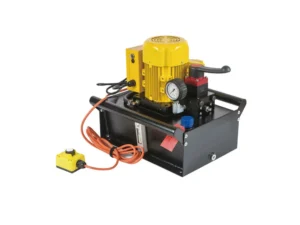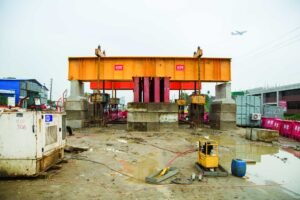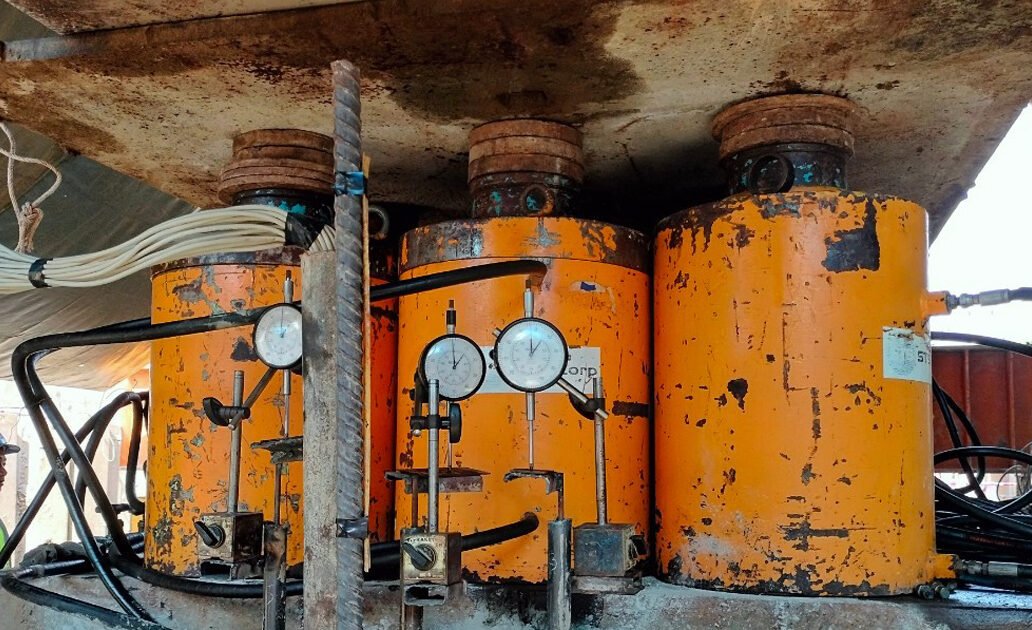Vertical Pile Load Tests Ensuring Strength and Stability
A vertical pile load test is a critical field procedure used to determine a pile’s load-bearing capacity and settlement behavior under a vertically applied load.
It is typically conducted after pile installation and before construction, ensuring the pile will support the design loads safely and efficiently. The test simulates the actual loads a pile will experience in service and helps verify design assumptions made during geotechnical and structural planning.
What Are the Different Types of Vertical Pile Load Tests?
There are primarily two main types of vertical pile load tests:
- Static Load Test
This test applies a gradual, controlled load to the pile, usually in increments, and measures the settlement response. It is considered the most accurate method for assessing pile performance under actual loading conditions. - Dynamic Load Test
A dynamic load test uses a hammer or drop weight to apply a sudden force to the pile head. Sensors measure the pile’s response, and the data is analyzed using wave equation methods to estimate load capacity.
Other variations include
- Maintained Load Test: Load is held constant for a period, and settlement is recorded.
- Cyclic Load Test: Load is applied and removed in cycles to evaluate pile performance under repeated loading.
At Forever Engineering Ltd., we offer a range of vertical pile load tests to suit the diverse needs of construction projects across various soil and structural conditions. We ensure that every pile meets safety, performance, and durability standards. Whether it’s a high-rise building or an industrial foundation, our expertise in pile testing supports the strength of your entire project.
Why Is a Vertical Pile Load Test Important in Foundation Engineering?
Vertical pile load testing plays a vital role in confirming the suitability of piles for the loads they are expected to carry. The test:
- Verifies pile design assumptions based on soil investigations.
- Identifies any issues with pile installation or construction quality.
- Ensures compliance with safety factors and regulatory standards.
- Reduces the risk of foundation settlement or failure.
- Helps optimize pile length and diameter, potentially lowering construction costs.
Without load testing, engineers would rely solely on theoretical data, which can be risky due to natural variability in soil conditions.
What Procedure for the vertical pile load test?
Preparation
- Select the pile to be tested.
- Clean the pile head properly and cut it to the designed level.
- Prepare the loading platform, usually with a reaction system like a reaction frame or kentledge blocks.
Setup of Testing Equipment
- Install a loading system, such as a hydraulic jack, on top of the pile.
- Place reaction beams or anchor piles securely to counter the test load.
- Set up dial gauges or electronic measuring devices around the pile to record vertical displacement.
- Ensure proper alignment of loading equipment vertically to avoid eccentric loading.
Initial Readings
- Before applying any load, record initial settlement readings from all gauges to zero readings.
Maximum Load Holding
- After reaching the maximum test load, hold it for a longer period.
Unloading Sequence
- Gradually release the load in steps.
- Record the pile rebound recovery at each unloading stage.
Data Analysis and Reporting
- Plot load vs. settlement graphs.
- Determine allowable load based on:
- Settlement criteria
- Load at which the creep rate exceeds acceptable values
- Prepare a detailed report showing procedures, observations, graphs, and conclusions
Forever Engineering Ltd follows the proper procedure for vertical pile load tests, ensuring accurate results, structural safety, and full compliance with engineering standards and best practices.

What Equipment Is Required for a Vertical Pile Load Test?
A vertical pile load test setup includes several key components:
- Hydraulic Jack: To apply vertical loads.
- Load Cells: For accurate load measurement.
- Dial Gauges or LVDTs: To monitor settlement.
- Reaction System: Kentledge blocks or tension piles to provide resistance.
- Steel Beams and Frames: For load transfer and alignment.
- Data Logging Equipment: Optional but useful for precise and continuous monitoring.
A successful vertical pile load test relies on the right combination of precise, durable, and well-calibrated equipment. At Forever Engineering Ltd., we provide a complete range of advanced and fully maintained pile load testing equipment for all types of construction projects. Whether it’s for static, dynamic, or uplift tests, our expert team ensures proper setup, operation, and monitoring to meet engineering standards and project specifications.
What Is the Difference Between Static and Dynamic Vertical Pile Load Testing?
The difference lies in how the load is applied and measured:
| Aspect | Static Load Testing | Dynamic Load Testing |
| Load Application | Gradually applied using hydraulic jacks | Applied suddenly using a falling hammer or weight |
| Purpose | Measures actual settlement under sustained load | Estimates capacity based on the pile’s response to impact |
| Accuracy | Highly accurate and reliable | Less accurate; depends on soil modeling and analysis |
| Time Required | takes longer | Much faster |
| Cost | More expensive due to equipment and time | More cost-effective for large-scale testing |
| Suitability | Ideal for critical structures needing detailed data | Suitable for quick checks or large projects |
Both methods have advantages and are often used together for comprehensive pile assessment.
Ensuring Safety During Vertical Pile Load Testing
Safety is a critical part of any vertical pile load test operation. Due to the high loads, heavy equipment, and potential energy stored in reaction systems, several important safety measures must be followed to protect workers, equipment, and the overall testing environment.
Pre-Test Planning and Risk Assessment
- Detailed Method Statement: Prepare a method statement outlining every step of the test, potential hazards, and control measures.
- Site Risk Assessment: Conduct a formal risk assessment considering load weights, stability, equipment operation, and ground conditions.
Equipment and Reaction System Safety
- Inspection of Equipment: All test equipment — jacks, load cells, dial gauges, beams, and frames — must be inspected, certified, and calibrated before use.
- Secure Reaction System: The reaction system must be properly designed and installed to prevent movement or failure under load.
Load Application and Monitoring
- Controlled Load Application: Load is applied slowly and in increments, according to a pre-approved loading schedule, to prevent sudden structural shocks.
- Continuous Monitoring: Displacements and loads are monitored continuously to identify abnormal behavior early.
Weather and Environmental Conditions
- Monitor Weather: Postpone testing during adverse weather conditions such as high winds, heavy rain, or lightning, which can compromise equipment stability and personnel safety.
Safe execution of a vertical pile load test requires thorough planning, proper equipment handling, trained personnel, careful monitoring, and clear emergency procedures.
What Are the Criteria for Evaluating the Results of a Vertical Pile Load Test?
The results of a vertical pile load test are primarily evaluated based on load-settlement behavior. Key criteria include:
- Ultimate Load Capacity: The load at which the pile shows continuous settlement without increased load. This is considered failure.
- Permissible Settlement: Defined limits of settlement under service loads, often based on building code standards.
- Load-Settlement Curve Shape: A smooth, curved graph is expected. A steep rise or sudden drop in the curve can indicate a problem.
- Recovery: In some tests, unloading is performed to observe how much of the settlement recovers, providing insight into soil elasticity and plastic deformation.
The analysis helps determine if the tested pile meets design requirements and if modifications are necessary in future pile design or installation methods. At Forever Engineering Ltd., we strictly follow and maintain all industry-recognized evaluation criteria on a project-specific basis. Our engineering team ensures that each pile is assessed with precision, using accurate data interpretation and high-quality instruments.

What Is the Maximum Load Applied in a Typical Vertical Pile Load Test?
The maximum load applied depends on the design load of the structure and the testing standard being followed. In many cases, the maximum test load is
- 1.5 to 2 times the design load for routine tests.
- Up to failure for ultimate load tests.
If a pile is designed to support 1000 kN, a typical test might apply up to 1500–2000 kN to verify safety factors. For critical or heavily loaded structures, higher multiples or extended testing procedures might be used.
How Does Soil Type Affect the Results of a Vertical Pile Load Test?
Soil type has a significant impact on pile performance. Different soils exhibit different load-bearing behaviors:
- Clayey Soils: Exhibit time-dependent settlement and may show large settlements under constant load. Piles may achieve more resistance from skin friction.
- Sandy Soils: Typically show immediate settlement, and load capacity may be more end-bearing dominant.
- Gravelly Soils: Provide high load-bearing capacity with minimal settlement.
- Soft or Loose Soils: Result in larger displacements and lower ultimate capacity.
Understanding the soil profile helps engineers anticipate pile behavior and choose appropriate pile types and load test methods.
How Long Does a Vertical Pile Load Test Usually Take?
The duration of a vertical pile load test depends on the type of test, loading procedure, and settlement behavior of the pile.
- Static Load Test: Can take 12 to 48 hours or more. Each load increment may be held for 30 to 120 minutes.
- Cyclic or Long-Term Tests: Can extend up to several days.
- Dynamic Load Test: Typically completed within a few hours.
The time required for each load step and the number of load increments directly affect the overall duration.
What Safety Precautions Must Be Taken During a Vertical Pile Load Test?
Safety is a top priority due to the involvement of high loads, heavy equipment, and pressurized systems. Key safety precautions include
- Proper Equipment Setup: Ensure hydraulic jacks, beams, and reaction systems are installed correctly and securely.
- Safe Working Zone: Establish clear boundaries and restrict access to the testing area during load application.
- Load Monitoring: Use calibrated instruments and automated data logging to reduce the need for manual readings near moving parts.
- Trained Personnel: Only experienced and trained engineers and technicians should handle the equipment and interpret data.
- Emergency Protocols: Be prepared for hydraulic failure, jack slippage, or sudden structural failure.
Safety is always a top priority. By following proper safety protocols, the risk of accidents and data errors can be significantly reduced. At Forever Engineering Ltd., we are committed not only to accurate testing but also to maintaining the highest standards of safety throughout the process. Our clients can rely on us for dependable results delivered with professionalism, precision, and complete peace of mind.
Conclusion
At Forever Engineering Ltd., we understand that the vertical pile load test is a vital part of ensuring the safety, reliability, and long-term performance of deep foundation systems. This test not only verifies the actual load-carrying capacity of piles but also confirms that our designs align with real-world ground conditions. By conducting both static and dynamic load tests with precision and care, we minimize risks and maximize structural integrity for every project we undertake.
With our commitment to engineering excellence, advanced testing equipment, and adherence to international standards, Forever Engineering Ltd. ensures that every pile we test meets or exceeds performance expectations. Trust us to deliver foundation solutions that are not only strong and stable but built to last.

